EVOLUTION GRADE 12 NOTES - LIFE SCIENCES STUDY GUIDES
Share via Whatsapp Join our WhatsApp Group Join our Telegram GroupEVOLUTION
LIFE SCIENCES
STUDY GUIDES AND NOTES
GRADE 12
- Evidence for evolution
- Sources of variation
- Theories of Lamarck and Darwin
- Applying the ideas of Lamarck and Darwin
- Activity 1
- Differences between natural selection and artificial selection
- Punctuated Equilibrium
- Speciation
- Activity 2
- Human evolution
- Activity 3
- Activity 4
- Activity 5
- Activity 6
CHAPTER 10: EVOLUTION
A theory is an explanation of something that has been observed in nature which can be supported by facts, generalisations, tested hypotheses, models and laws.
A hypothesis is a possible solution to a problem.
10.1 Evidence for evolution
- Fossil evidence: The evidence that shows characteristics that make us similar to, or different from African apes comes largely from a study of fossils (thousands of fossil fragments).
- Genetic evidence: Scientists state that organisms are closely related and are likely to have a common ancestor if they have:
- Identical DNA structure
- Similar sequence of genes
- Similar portions of DNA with no functions and
- Similar mutations (mitochondrial DNA)
Species that are closely related have a greater similarity to each other than distant species.
- Cultural evidence: Cultural evidence from studies of tools and weapons, as well as language is also used to show similarities and differences between humans and African apes.
10.2 Sources of variation
The genotypes and therefore phenotypes (appearance) of individuals of the same species are different from each other because:
- Crossing over in Prophase I of meiosis involves an exchange of genetic material, leading to new combinations of maternal and paternal genetic material in each new cell resulting from meiosis.
- Random arrangement of maternal and paternal chromosomes at the equator during metaphase allows different combinations of chromosomes/chromatids to go into each new cell resulting from meiosis, making them different.
- Random fertilisation between different egg cells and different sperm cells formed by meiosis result in offspring that are different from each other.
- Random mating between organisms within a species leads to a different set of offspring from each mating pair.
- A mutation changes the structure of a gene or chromosome and therefore the organism’s genotype. Since the genotype influences the phenotype, it creates organisms with new, different characteristics from one generation to the next.
10.3 Theories of Lamarck and Darwin
Jean-Baptiste Lamarck explained evolution using the following two ‘laws’:
- The inheritance of acquired characteristics:
Characteristics developed during the life of an individual (acquired characteristics) can be passed on to their offspring. - The law of use and disuse:
As an organism uses a structure or organ more regularly, it becomes better developed or enlarged. If an organism does not use a structure or organ frequently, it becomes less developed or reduced in size and may disappear altogether.
Charles Darwin explained evolution in terms of natural selection which states that:
- There is a great deal of variation among members of the same species.
- Organisms with favourable characteristics, which enable them to cope with challenges in the environment, survive.
- Organisms which do not have favourable characteristics that allow them to cope with challenges in the environment, die.
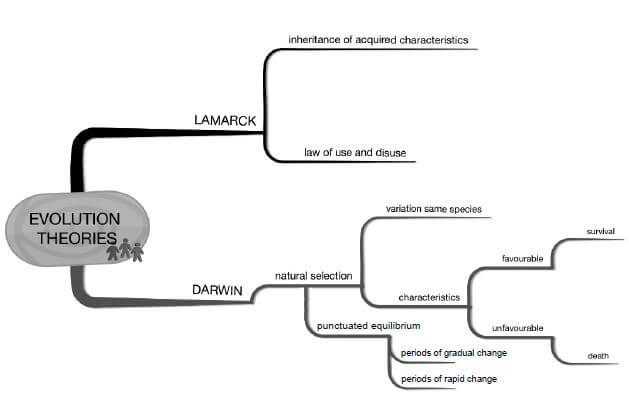
10.4 Applying the ideas of Lamarck and Darwin
Figure 10.1 below shows a series of changes involving cacti plants over a period of time. Some notes are included on the events at A, B and C.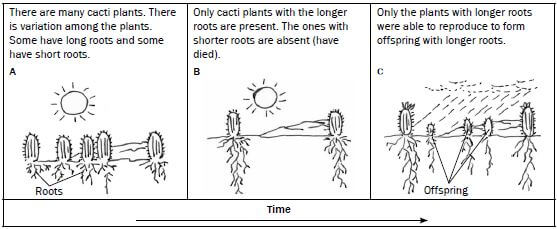
Figure 10.1 Changes in cacti plants over time
We can use Figure 10.1 to describe how Darwin would have explained how modern cacti plants may have developed longer roots as compared to their ancestors with shorter roots.
The second column in Table 10.1 below gives Darwin’s explanation of how modern cacti plants may have developed longer roots. The first column contains questions
that guide the explanation from one point to the next. You will be able to use the same questions to guide you when answering questions on Darwin’s theory using any other
example, for example the development of longer necks in modern giraffes.
| Guiding questions | Darwin’s explanation |
Describe the variation in the population. | As a result of genetic variation ✔ in the cacti population, some cacti plants had longer roots than others.✔ |
What was the challenge? | As a result of drought ✔, competition for water occurred. |
What was the result of the challenge? | Plants with shorter roots died✔ and those with longer roots survived.✔ |
What is this called? | This is called natural selection.✔ |
What happened to the favourable characteristic? | The allele for longer roots was passed on to subsequent generations.✔ |
What was the result of this? | Eventually all the plants had longer roots.✔ |
Table 10.1 Darwin’s explanation for changes in cacti plants over time
The second column in Table 10.2 below states how Lamarck would have explained how modern cacti plants may have developed longer roots when compared to their ancestors with shorter roots. The first column contains guiding questions that will help you answer other questions on Lamarck’s theory using any other example, for example the development of longer necks in modern giraffes.
| Guiding questions | Lamarck’s explanation |
| What was the original characteristic at the start? | All cacti had short roots✔ originally. |
What did the organism do? | Cacti frequently stretched ✔ their roots. |
Why did the organism do this? | They did this to reach deeper for water in the soil.✔ |
What was the result? | As a result, the roots became longer.✔ |
What happened to this new characteristic? | The characteristic of long roots acquired in this way was then passed on to the next generation ✔ |
What was the result of this? | Eventually all the plants had longer roots.✔ |
Table 10.2 Lamarck’s explanation for changes in cacti plants over time
Activity 1
Questions
- Write an account showing how Lamarck would have explained the development of longer necks in modern giraffes. (5)
- Write an account showing how Darwin would have explained the development of longer necks in modern giraffes. (7)
- Explain why Lamarck’s theory was rejected. (2) [14]
Answers to activity 1
1.
- All giraffes had short necks✔ originally.
- These giraffes frequently stretched✔their necks.
- They did this to reach the leaves that were available only higher up on the trees.✔
- As a result, their necks became longer.✔
- The characteristic of long necks acquired in this way was then passed on to the next generation.✔
- Eventually all the giraffes had longer necks.✔ (5)
2.
- As a result of genetic variation✔ in the giraffe population some giraffe had longer necks than others.✔
- As a result of leaves being available only higher up on trees,✔ giraffes competed for these leaves.
- Giraffes with shorter necks died.✔
- Giraffes with longer necks survived.✔
- This is natural selection.✔
- The allele ✔ for longer necks was passed on to subsequent generations.✔
- Eventually all the giraffes had longer necks.✔ (7)
3. There is no evidence ✔ to show that acquired characteristics are inherited ✔/There is no evidence that structures used more frequently become more developed or vice versa (2) [14]
10.5 Differences between natural selection and artificial selection
For a long time, humans have been doing breeding experiments to develop organisms with a selected set of desirable characteristics, for example increased quality and quantity of milk produced by cows, or drought resistance and increased sugar content in sugar cane.
This is achieved by artificial selection, which is a similar process to natural selection. However, artificial selection differs from natural selection in the following ways:
Natural selection | Artificial selection |
The environment or nature is the selective force. | Humans represent the selective force. |
Selection is in response to suitability to the environment. | Selection is in response to satisfying human needs. |
Occurs within a species. | May involve one or more species (as in cross breeding). |
Table 10.3 The differences between natural selection and artificial selection
10.6 Punctuated Equilibrium
Based on the explanations of Lamarckism and Darwinism, it is thought that evolution takes place through an accumulation of small or gradual changes that occur over a long period of time. This is supported by the many transitional fossils in the fossil record which show the progressive change over time.
Punctuated equilibrium is a hypothesis that explains the speed at which evolution takes place through natural selection: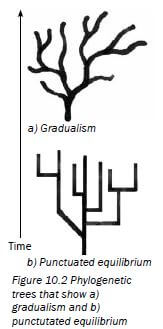
- According to punctuated equilibrium, evolution is not always gradual as proposed by Lamarckism and Darwinism.
- Evolution involves long periods of time where species do not change or change very little (known as equilibrium).
- This alternates with (is punctuated by) short periods of time where rapid changes occur.
- As a result, new species are formed in a short period of time, relative to the long periods of no/little change.
- This is supported by the absence of transitional fossils (usually termed ‘missing links’) indicating the period of rapid change.
10.7 Speciation
As a result of natural selection taking place over a period of time, the characteristics of organisms may change to such an extent that they cannot reproduce with the original members of that species to produce fertile offspring. We say that they have become a new species. This is called speciation.
We can describe the process of speciation as follows:
10.7.1 Speciation
A population of a particular species may become split by a geographical barrier, e.g. a river. As a result, the two parts of the population cannot interbreed. There is no gene flow between the two populations.
Natural selection occurs independently in each population. This is due to different environmental conditions. As a result, the two populations become genotypically and phenotypically different over a period of time. Even if the two populations mixed at a later time, they will not be able to interbreed again. We say that one or both parts of the population have become a new species = speciation.
10.7.2 Mechanism for reproductive isolation
Geographic isolation causes speciation. Reproductive isolation isolates the gene pool of a species. Examples of reproductive isolation:
- Breeding at different times of the year.
- Species-specific courtship behaviour.
- Adaptation to different pollinators in plants.
- Infertile offspring.
Activity 2
1. Use the information in Figure 10.3 below to explain how a new species of rabbit has arisen because of a geographical barrier. [9]
Figure 10.3 Speciation in a rabbit population
2. The diagram below represents the changes in a population of bacteria over time as a result of exposure to an antibiotic over time.
Figure 10.4. Development of antibiotic resistance in a bacteria population
Explain, in terms of natural selection, the shift in the resistance level of the bacteria illustrated above. [8]
Answer to activity 2
-
- A population of rabbits become split✔ by a geographical barrier/river✔
- As a result, the two parts of the population cannot interbreed.✔
- There is no gene flow✔ between the two populations.
- Natural selection occurs independently✔ in each population due to different environmental conditions✔ on either side of the river.
- As a result, the two populations become genotypically and phenotypically different✔over a period of time.
- Even if the geographical barrier is removed (ie the river returns to its normal course at some later time), the rabbits will not be able to interbreed again.✔
- We say that one or both parts of the rabbit population have become a new species✔. [9]
- There is a large degree of variation in the bacteria population✔
- When the antibiotic was first used, it killed off a large number of bacteria✔
- But some bacteria were resistant to the antibiotic✔ and survived✔
- Those that survived were able to reproduce✔
- Increasing the population of resistant bacteria✔
- Continued use of the antibiotic had little effect on the resistant bacteria✔
- Hence the resistant bacteria increased✔
- And non-resistant bacteria decreased✔ [8]
10.8 Human evolution
So far in this chapter you have seen that:
- As a result of natural selection, the characteristics of organisms can change over time due to changing environmental conditions
- New species can arise when a group of organisms change so much that they can no longer reproduce with the original species (this is called speciation).
Natural selection and speciation can also be used to explain how humans have evolved.
Scientists identify trends in human evolution by comparing humans to other primates in terms of similarities and differences. The differences point to the existence of different species, while the similarities point to a possible common ancestor.
10.8.1 Similarities between humans (Homo sapiens) and African apes
Figure 10.5 below shows characteristics of humans that are similar to that of African apes.
Figure 10.5 Characteristics humans and African apes have in common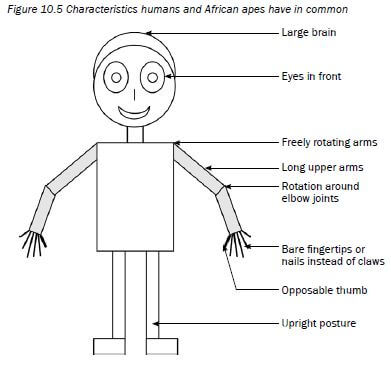
Now try this:
- Cover the labels on Figure 10.5 and try to list the common features of humans and African apes by looking at the parts that the arrows are pointing to.
- Write down the EIGHT similarities without looking at the diagram.
10.8.2 Differences between humans (Homo sapiens) and African apes
Table 10.4 below is a comparison between the anatomical characteristics of Humans (Homo sapiens) and African apes according to the features listed in the first column.
FEATURE | Humans (Homo sapiens) | African Apes |
Cranium | Large cranium/brain | Small cranium/brain |
Brow Ridges | Brow ridges are not well developed | Brow ridges well developed |
Spine | More curved spine (S-shaped spine) | Less curved spine (C-shaped spine) |
Pelvic girdle | Short, wide pelvis | Long, narrow pelvis |
Canines | Small canines | Large canines |
Palate shape | Small and semi-circular | Long and rectangular |
Jaws |
|
|
Cranial ridges | No cranial ridge | Cranial ridge across the top of the cranium |
Foramen Magnum | Foramen magnum in a forward position | Foramen magnum in a backward position |
Table 10.4: The anatomical differences between humans and African apes.
Now try this:
1. Study the differences listed in Table 10.4 above by referring to the These are easy features shown in Figure 10.6 below.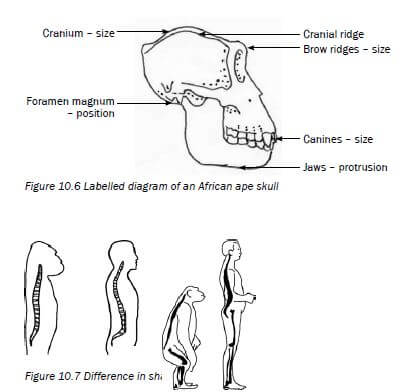
2. Now write down the differences using the above diagrams but without referring to Table 10.4.
Activity 3
Question 1
Study the two skulls shown in Figure 10.8 below and answer the questions that follow.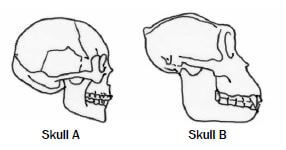
Figure 10.8 Skull diagrams of two organisms
1.1 Which skull (A or B) is that of a non-human primate? (1)
1.2 List FIVE OBSERVABLE reasons (based only on features that are visible in the diagram) for your answer in question 1.1. (5) [6]
Answers to question 1
1.1 Skull B✔ (1)
1.2
- Pronounced brow ridge✔
- Protruding jaw/prognathous✔
- Large canine✔
- Small cranium✔
- Cranial ridge across the top of the cranium✔ (5) [6]
Question 2
The diagrams in Figure 10.9 below represent the skulls of three organisms:
Taung child (Australopithecus africanus), a modern human (Homo sapiens) and a gorilla (Gorilla gorilla). The arrow indicates the position of the foramen magnum (the opening that allows the spinal cord to connect with the brain). Study the diagrams and answer the questions that follow:
Figure 10.9 Skull diagrams showing the position of the foramen magnum
2.1 Identify the organisms that are represented by each of skulls A, B and C. (3)
2.2 Assuming that the diagrams were drawn to scale, list THREE observable differences between the skulls of organisms A and B. (6)
2.3 By looking at the position of the foramen magnum (indicated by the arrows), state which TWO organisms are best adapted for walking on two legs rather than four legs. (2)
2.4 Explain, using observable features, why the organism to which skull C belongs can be regarded as a transitional species (a species that is in the process of changing). (3) [14]
Answers to question 2
2.1
- - Homo sapiens/human✔
- - Gorilla gorilla/gorilla✔
- - Australopithecus africanus (Taung child)✔ (3)
2.2
| Skull A | Skull B |
| Brow ridge reduced/absent✔ | Pronounced brow ridge✔ |
Non-prognathous/non-protruding jaw✔ | Prognathous/protruding jaw✔ |
Poorly developed canines✔ | Large canines✔ |
No cranial ridges✔ | Cranial ridges present✔ |
Large cranium✔ | Small cranium✔ |
(any 3 × 2) (6)
2.3 Homo sapiens/huma✔ AND Australopithecus africanus (Taung child)✔ (2)
2.4 It has features of the skull that are intermediate✔ between that of skulls A and B, e.g. jaw protrudes more than in skull A but less than in skull B✔, face not flat in skull of B but flat in skull A. (3) [14]
10.8.3 Major phases in hominid evolution
The table below shows the characteristics of different organisms (as obtained from a study of their fossils) that are thought to be in the same line that led to the evolution of modern humans. The fossils are dealt with in the order in which they appeared on Earth (as calculated by the age of the fossil using dating techniques).
Organism | When organism existed | Fossil site | Discovered by | Characteristics |
Ardipithecus ramidus | 5 - 4 mya | North-East Ethiopia | Tim White | Brain size: 300-350 ml Forward position of foramen magnum Very prognathous (more protruding jaws) Heavy brow ridges Pelvis structure: bipedal and tree climbing |
Australopithecus afarensis | 4 - 2,7 mya | Ethiopia, Kenya, Tanzania | Donald Johanson | Brain size: 375-550 ml Forward position of foramen magnum Very prognathous Heavy brow ridges Canines large and pointed Long arms No cranial ridge |
Australopithecus africanus | 3 - 2 mya | Taung; Sterkfontein | Raymond Dart | Brain size: 428-625 ml Forward position of foramen magnum Prognathous Brow ridges Teeth large, canines not long Long arms No cranial ridge |
Australopithecus sediba | 1,9 - 1,8 mya | Malapa Cave - in the cradle of humankind | Lee Burger | Brain size: 420 ml Less prognathous Brow ridges Large teeth, canines not long Long arms No cranial ridge |
Homo habilis | 2,2 - 1,6 mya | Tanzania | Louis and Mary Leakey | Brain size: 650 ml Less prognathous Less pronounced brow ridges Human-like teeth - smaller canines Long arms |
Homo erectus | 2 - 0,4 mya | Java in Indonesia and then Swartkrans | Eugene Dubois | Brain size: 900 ml Prognathous Cranial ridges Short canines Longer legs and shorter arms |
Homo sapiens | 200 000 years ago - present | Makapansgat in Limpopo; Border Cave in KZN; Blombos Cave in the Western Cape | Tim White | Brain size: 1200-1800 ml No brow ridges Small teeth Short arms |
Activity 4
- What general observation can you make about the characteristics as one moves from the earlier to the later organisms listed in the table? (2)
- Use information in the table to describe the specific evolutionary trend (how each of the features changed over time) relating to each of the following characteristics:
2.1 Brain size
2.2 Position of foramen magnum
2.3 Prognathous jaws
2.4 Dentition
2.5 Development of brow ridges 5 × 2 (10) - State the significance of the changes that occurred as they apply to each of the following characteristics:
3.1 Brain size
3.2 Position of foramen magnum
3.3 Prognathous jaws
3.4 Dentition
3.5 Development of brow ridges 5 × 2 (10) - Explain how the information in the table provides evidence for the ‘Out of Africa’ hypothesis. (2) [24]
Answers to activity 4
1. There is a gradual change in the characteristics✔ over a period of time. ✔ (2)
2. 2.1 Brain size: Increase✔ in brain size✔
2.2 Position of foramen magnum: Movement to a more✔ forward position✔
2.3 Prognathous jaws: Change from more prognathous✔ to less prognathous✔
2.4 Dentition: Decrease in the size✔ of the teeth✔ OR decrease✔ in the size✔ of the canines
2.5 Development of brow ridges: Brow ridges become less✔ developed✔ 5 × 2 (10)
3. 3.1 Brain size: Increased brain size allows for processing information more quickly ✔and for processing a larger amount of information. ✔
3.2 Position of foramen magnum: More forward position of the foramen magnum✔ indicates bipedalism. ✔ A decrease in the length of the arms indicates a decreased dependency on its use in locomotion and therefore shows a more advanced stage of bipedalism. This is usually accompanied by an increase in the length of the legs.
3.3 Prognathous jaws: A less prognathous jaw indicates a smaller jaw. ✔ A small jaw is sufficient since there was a change from eating raw food to eating cooked food. ✔
3.4 Dentition: The change from large to smaller teeth✔was due to the change in diet from raw food to cooked food✔
3.5 Development of brow ridges: Brow ridges became less developed since the action of the smaller jaws✔did not create forces great enough for the skull to have increased strength from the brow ridges✔ 5 × 2 (10)
4. The information in the table shows that fossils of the different organisms that are considered to have existed in the same line as humans✔ were all found in Africa. ✔ (2) [24]
10.8.4 Out of Africa hypothesis
The ‘Out of Africa’ hypothesis states that modern humans originated in Africa and then migrated out of Africa to the other continents.
The following lines of evidence have been used to support this hypothesis:
- The oldest fossils of australopithecines/Homo habilis/bipedal organisms have been found in Africa.
- The oldest fossils of Homo erectus have been found in Africa.
- Analysis of mutations in mitochondrial DNA shows that the oldest female ancestors of humans are from Africa.
10.8.5 Phylogenetic trees
A phylogenetic tree (or evolutionary tree) represents the possible evolutionary relationships among a set of organisms or groups of organisms. The tips of the tree represent descendants (often species) and the points where the tree branches represent the common ancestors of those descendants.
Hints on interpreting phylogenetic trees
hint Reading a phylogenetic tree is similar to understanding a family tree. The root of the tree represents the ancestor and the tips of the branches represent the descendants of that ancestor. As you move from the root of the tree to its tips, you are moving forward in time.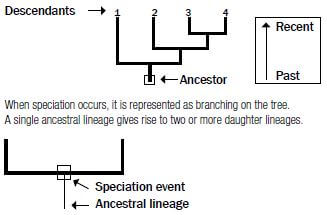
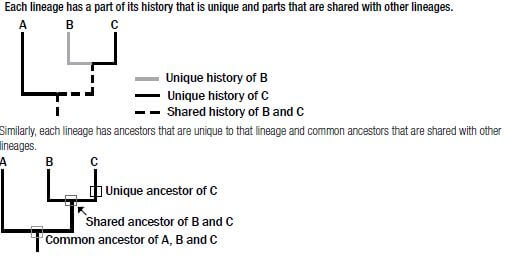
Worked exampleLook at the phylogenetic tree in Figure 10.10 and read the following information:
| 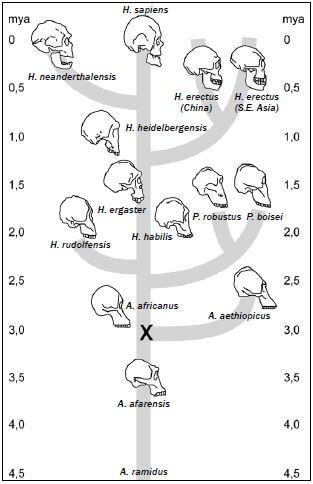 |
Questions
Let us look at the type of questions that can be asked about this phylogenetic tree:
- Give the common ancestor of H. neanderthalensis and H. sapiens. (1)
- How long ago did H. rudolfensis split from its common ancestor? (2)
- Name the direct ancestor of H. ergaster. (1)
- How long has it taken H. heidelbergensis to evolve from A. afarensis? (3)
- Give the common ancestor of all the hominids. (1) [8]
Answers
- H. heidelbergensis✔ (1)
- 2,4✔ million years ago✔/mya (2)
- H. habilis✔ (1)
- 3,8 million years ago - 0,7 million years ago✔ = 3,1✔million years✔ (3)
- A. ramidus✔ (1) [8]
Activity 5
Study the phylogenetic tree in Figure 10.11 below and answer the questions based on it.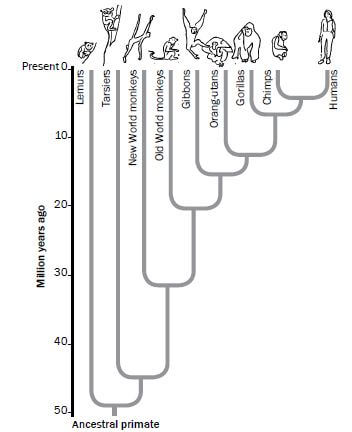
Questions
- How long ago did the ancestral primate live on earth?(2)
- Name the organism that shares the most distant common ancestor with humans.(1)
- Name the organism that is most closely related to humans. (1)
- How many years ago did the New World monkeys split from the common ancestor that gave rise to the Old World monkeys? (2)
- For how long did the common ancestor that evolved into the gibbons exist? Show your working. (3)
- Humans and gorillas share many common characteristics with primates. List THREE of these common characteristics. (3)[12]
Answers to activity 5
- 50✔ million years ago✔/mya (2)
- Lemurs✔ (1)
- Chimpanzee✔ (1)
- 33✔ million years ago✔/mya (2)
- 22 million years - 15 million years✔ = 7✔million years✔ (3)
-
- Large brain✔
- Eyes in front✔
- Freely rotating arms✔
- Long upper arms✔
- Rotation around elbow joints✔
- Bare fingertips or nails instead of claws✔
- Opposable thumb✔
- Upright posture✔ (any 3) (3) [12]
Activity 6
Question 1
Give the correct biological term for each of the following descriptions. Write only the term next to the question number (1.1 to 1.17).
1.1 The development of new species from existing species.
1.2 A study of the distribution of organisms in different parts of the world.
1.3 Similar structures in different organisms indicating common ancestry.
1.4 Having a pointed face because of projecting jaws and nose.
1.5 A group of similar organisms that can breed to produce fertile offspring.
1.6 A group of organisms of the same species that occupy a particular habitat.
1.7 Only organisms with favourable characteristics survive.
1.8 Using parents with particular desirable characteristics to obtain a combination of these desirable characteristics in the offspring
1.9 An opening in the skull through which the spinal cord passes
1.10 Locomotion involving the use of a pair of hind limbs only
1.11 Mechanisms that prevent different species from reproducing with each other
1.12 The study of fossils which provides evidence for evolution
1.13 Sudden change to the genetic composition of an organism
1.14 Branched diagram showing evolutionary relationships among organisms
1.15 Remains of organisms that have existed in the past
1.16 Genus to which Little Foot, Mrs Ples, Karabo and the Taung Child belong
1.17 Genotypic and phenotypic differences among organisms of the same species [17]
Answers to activity 6
1.1 Speciation✔
1.2 Biogeography✔
1.3 Homologous✔
1.4 Prognathous✔
1.5 Species✔
1.6 Population✔
1.7 Natural selection✔
1.8 Artificial selection✔
1.9 Foramen magnum✔
1.10 Bipedal✔
1.11 Reproductive isolation✔
1.12 Paleontology✔
1.13 Mutation✔
1.14 Phylogenetic tree✔
1.15 Fossils✔
1.16 Australopithecus✔
1.17 Variation✔ [17]